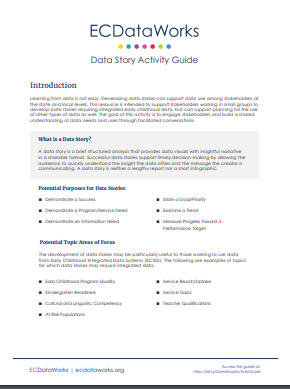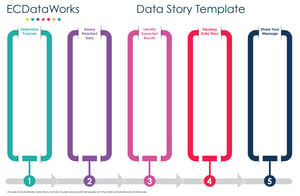This post was co-authored by Phil Sirinides from the University of Pennsylvania Consortium for Policy Research in Education (CPRE).
Developing data stories can help state administrators and state/local program staff share their learning to inform strategies and program improvement.
Data stories serve as a communication tool that can lead to dialogue, collaboration, and informed decision making. Creating data stories can streamline program and policy decisions, improve transparency, and lead to consistent and useful reports for state administrators and policymakers.
To support the development of data stories, ECDataWorks, a partnership with W.K. Kellogg Foundation and conducted by the University of Pennsylvania’s Consortium for Policy Research in Education (CPRE) developed the Data Story Activity Guide. The guide can be used with a broad range of stakeholders within or outside of early childhood.
A data story is a brief structured analysis that provides data visuals with insightful narrative in a sharable format. Successful data stories support timely decision making by allowing the audience to quickly understand the insight the data offer and the message being communicated. A data story is neither a lengthy report nor a short infographic.
A data story can serve various purposes. For example, it may demonstrate a success or a program/service need, or it may measure progress toward a specific performance target. Data stories can be used in any field. In early childhood, they may focus on topics such as school readiness, program quality, or teacher qualifications.
Let’s walk through a scenario.
A state agency has identified “providing high-quality programs to children in poverty” as one of their strategic goals for a five-year period. Near the end of the five-year period, a team of staff is asked to share an update at a meeting about the progress the state has make toward this goal. The team is tasked with demonstrating that access to high-quality early childhood programs in areas of high poverty has increased in the past five years. The purpose of this data story is to demonstrate a success and the team will use data on early childhood program quality, service reach/uptake, and at-risk populations. The team develops a clear data story to share with attendees of the meeting. They hope that state administrators will use the key takeaway from the data story to establish continued funding for the efforts that have been effective over the last five years. To create their data story the administrators used the below 5-step planning process.

The Data Story Activity Guide outlines a five-step planning process for developing a data story.
What is the purpose of your data story? In addition to identifying key questions of interest, consider why a data story is useful and how it would lead to actionable results.
Are the data required for your data story available and accessible? Consider whether additional time or activities will be required to ensure quality data or integrate across data sources.
What results do you expect from the analysis? Consider what tools you would need to analyze the data and how you might visualize and communicate these results effectively.
Identify your audience and customize your data story to meet their needs. Decide how to organize data, what context to provide, and how to help the audience understand the key messages.
Consider when and where sharing your message would be most powerful. Identify what decisions your audience could make using the data story, and how you will know if the data story has served its intended purpose.
Stakeholder engagement is key in planning for data use, and specifically for developing data stories. The ECDataWorks Data Story Activity Guide can help facilitate conversations with stakeholder groups to take them from identifying questions of interest to developing data stories and using data to make decisions. It was designed to be completed in person with small, diverse groups of people, but can be used in other settings as well. Check out the full Data Story Activity Guide for additional guidance, facilitation information, and materials.
We tend to think about child care as a family issue and a business issue. Four decades ago, the fact is that child care became a “military readiness” issue when the draft was eliminated in favor of an all-volunteer force. With the resulting influx of families and children, child care was needed to reduce the conflict between military mission requirements and parental responsibilities.
Yes, it is important to go to your office or cubicle and perform the day-to-day routines of collecting data, reporting federal and state data, and running ad-hoc data requests.
This post was co-authored by Ruth Lett and Nancy Copa.